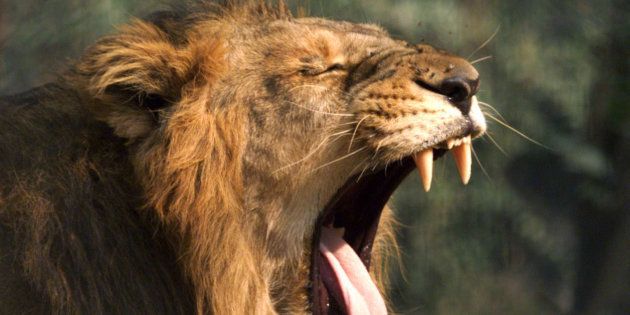
Here's some good news: Gujarat has reported a record high of 650 Asiatic lions in the state's forests and national parks. This is the highest number of Asiatic lions, found only in Gujarat, recorded since 1936, reported The Times Of India.
With about 180 cubs between one and two years of age, Gir National Park and its surrounding forests are packed with majestic Asiatic lions (Indian lions). In the last two years alone, the area has added about 125 lions to its numbers. In 2015, the lion census pegged the population at the national park at 523.
A lion population counting exercise, which is undertaken every full moon day, revealed the happy numbers. About 100 CCTV cameras as well as the direct sighting method of counting are used to arrive at a number. This count is then cross-checked with the recorded number of kills and daily reports by on-ground beat guards. An average Asiatic lion is 8.2 feet to 9.5 feet tall and weighs between 200 to 250 kg.
Between 1995 and 2015, more than 40 per cent of the total number of lions was spotted outside the Gir landscape.
Clearly, the state's efforts to protect and conserve the big cats have been successful, with a steady rise in the population since lions were declared 'critically endangered' in 2000. In the 1995 census it was found that Gir had only 304 lions. In 2005, lions were removed from the list. In 2010, there were 411 lions.
Forest minister Ganpat Vasava told TOI, "The steady rise in lion population is a good sign and indicative of robust conservative measures undertaken by the state."
"The expanding lion population is a sign of strengthening of the satellite population of big cats outside Gir National Park. It is a welcome sign indicating risk mitigation and robust growth of lions," TOI quoted Priyavrat Gadhvi, a member of the state board for wildlife, as saying. The fact that there has been an increase in the population not just in Gir but its periphery areas as well is of significance because in 2015, there were concerns about the growing number of lions without adequate management by wildlife authorities, after a number of man-animal run-ins were reported. According to a 2017 report published in science journal Current Science, between 1995 and 2015, more than 40 per cent of the total number of lions in Gujarat was spotted outside the Gir landscape.

Gir wildlife sanctuary was established in 1965 as the first protected area (PA) in Gujarat to conserve the Asiatic lion. Since then, there have been several expansions. Currently, five PAs — Gir national park, Gir sanctuary, Pania sanctuary, Mitiyala sanctuary and Girnar sanctuary — together spread over 1,621 sq km are managed as the Asiatic lion's habitat.
Despite the increasing numbers, there have been worries that the growth in the lion population cannot be sustained in Gujarat in the coming years. "Not just lion-human conflicts but other problems too, like unnatural deaths and genetic disorders, will surface. Keeping lions only in Gujarat is also against international norms," Ajay Dubey, the secretary of Prayatna, an NGO, told Mint.
For a long time, wildlife activists and environmentalists have been concerned about the entire Asiatic lion population being concentrated in Gujarat, worried that an epidemic or natural calamity could wipe out the entire species.
In 2013, the Supreme Court had ordered the ministry of environment, forests and climate change (MoEFCC) to shift some of Gujarat's lions to the Kuno Palpur wildlife sanctuary in Madhya Pradesh. Even though Kuno can hold about 40 lions, so far not a single lion has been translocated to the sanctuary.
Gujarat government has refused to share the lions until 33 studies mandated by the International Union for Conservation of Nature (IUCN) are completed.
BJP-ruled MP and Gujarat have been struggling over the issue of lions for over a decade, since the chief minister of Gujarat between 2002 and 2014, the now Prime Minister Narendra Modi, declared the Asiatic lions to be the 'pride of Gujarat'.
While Gujarat has, in theory, not opposed the translocation of lions, it has created several hurdles in the relocation process. In March, the minutes of an environment ministry's expert committee meeting disclosed that even though the committee had approved Kuno as a suitable home for Asiatic lions, the Gujarat government had refused to send lions until 33 studies mandated by the international wildlife watchdog International Union for Conservation of Nature (IUCN) are completed. The state claimed preparing an action plan for relocation without studying the results of these studies was not advisable.
Also on HuffPost
